There has been a lot of talk lately about whether or not selling on Amazon is a profitable strategy for direct-to-consumer (DTC) brands. Many, like Nike and Ikea, have opted to leave the site, choosing to sell solely on their own websites instead.
For countless other DTC brands, however, Amazon is still a critical sales channel, and one key to their success.
So, what types of companies or DTC brands can be successful on Amazon?
We’ve sourced insights from DTC companies selling successfully on Amazon — like food brands Justin’s and Country Archer — to explore the limitations of DTC, the benefits of having a presence on Amazon, and what brands need to know in order to stay ahead of their competition.
What is Direct to Consumer (DTC)?
Like the name implies, direct-to consumer brands sell their products directly to their customers. This is achieved through their own website, and/or their own physical storefront.
In other words, you won’t find DTC brands in retail stores like Walmart or Target. And you won’t find them on e-commerce retail sites like Amazon, eBay, or Zappos.
For example, brands like Beltology and David Kind sell exclusively online through their own websites, whereas Brilliant Earth and Warby Parker have both e-commerce and brick and mortar stores.
Are there limitations when selling strictly DTC?
According to Jonathan Willbanks and Chris Moe, co-founders of Cartograph — an agency focused on supporting food brands selling on Amazon — the answer is yes.
In fact, the biggest limitation with direct to consumer marketing is its method of distribution.
DTC brand puts their products directly into the hands of their customers themselves — ie. without using a third party. This means that a direct-to-consumer brand must manage every aspect of a sale. They also have to ensure that their customer has a positive shopping experience.
This is extremely difficult, particularly when the customer doesn’t have an established relationship with the brand and is coming into the relationship with high expectations.
Many people are uncomfortable entering their financial information or mailing address into unfamiliar websites. Or, they don’t like the uncertainty of shipping times and return policies.
Amazon, on the other hand, acts as a “middleman” between its customers and the brands offering products on its site. And, generally speaking, consumers trust Amazon and know how it works.
Many have used the platform before, have their shipping and credit card information stored, and all they have to do is click once to make their purchase.
Therefore, Amazon is a smoother and more familiar shopping experience for many shoppers, relative to DTC. Consequently, for a large number of people, Amazon is their only experience with e-commerce platforms.
So, if a brand is only selling through their own website (and/or a brick and mortar store that doesn’t happen to be in the same vicinity of their potential customers), they could lose the sales of people only willing to buy on Amazon.
5 benefits of selling DTC brands on Amazon
Is an easy and routine shopping experience the only reason direct-to-consumer brands should join Amazon? Absolutely not!
Though it’s one of the best and most inexpensive distribution methods available, there are many benefits to selling on Amazon
1. It’s one of the most efficient ways to reach customers — particularly for U.S.-based shoppers.
And the reason it’s so effective is because 66% of new product searches begin on Amazon today vs 20% on search engines, and 4% on a brand website.
Basically, Amazon has replaced Google when it comes to finding products.
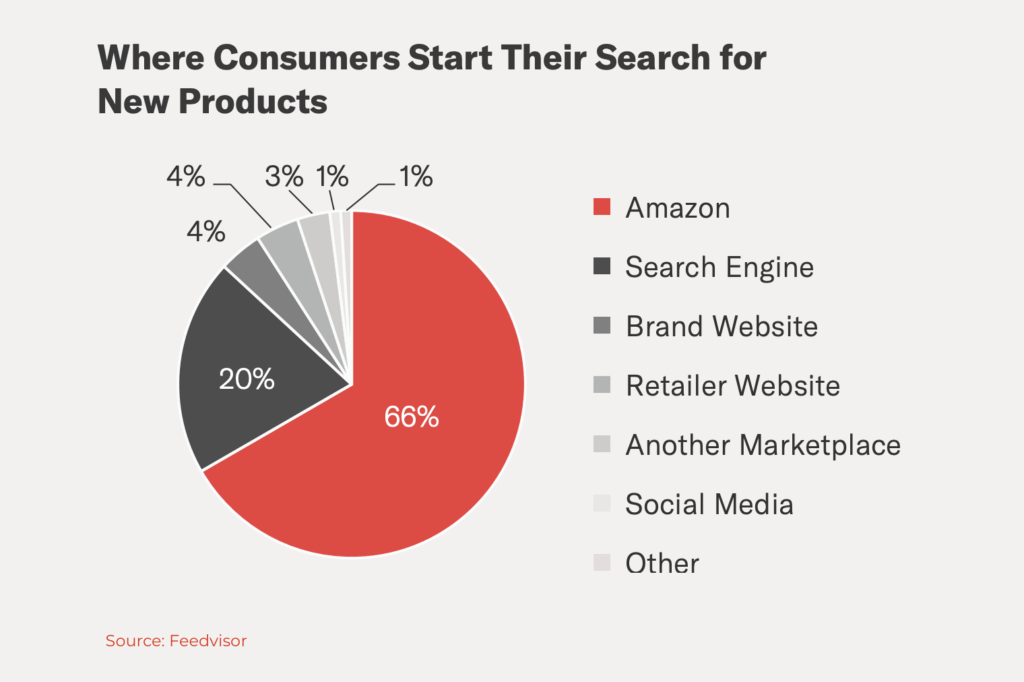
2. The positive reviews on a product’s Amazon page can boost the brand’s sales on other channels — including their own.
Because so many shoppers turn to Amazon when doing product research, customers tend to read its reviews first. And those Amazon comments inform the customer’s decision on whether or not to buy a product.
Even when a shopper plans to buy an item from a physical retail store, people often read the product’s reviews on Amazon before purchasing the product at a brick and mortar store.
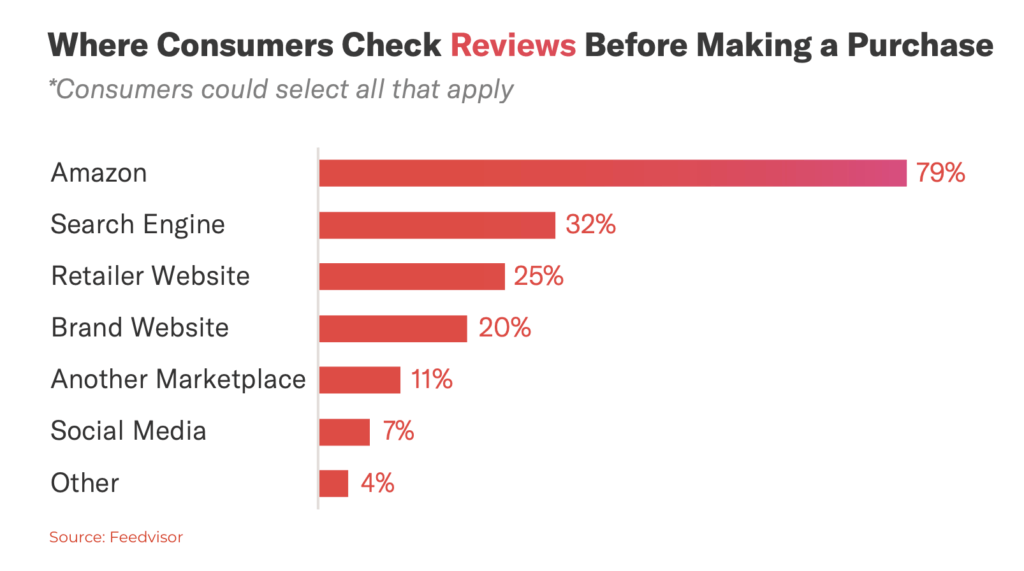
3. Amazon can end up being a significant part of a brand’s bottom line, even if they are an internet-first brand.
Amazon can make up anywhere from 10 to 40% of Cartograph’s DTC clients’ total retail sales. In fact, a couple of the brands they support are making $150,000 to $200,000 in revenue per month on Amazon.
And, based on Feedvisor’s 2019 research, 42% of survey respondents selling on Amazon said the platform accounts for over half of their online revenue.
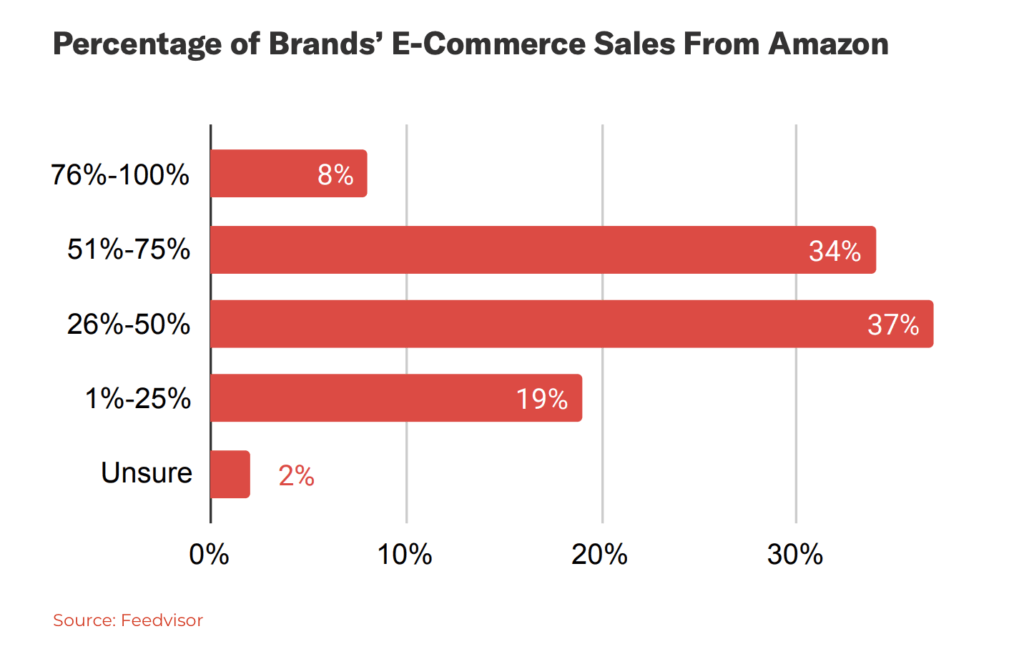
4. Amazon’s advertising costs can be up to 10% cheaper than DTC’s ad costs.
And when it comes to profit margins bigger is better, with the difference often coming down to organic vs paid traffic.
DTC website traffic is usually paid traffic. Shoppers are directed to the platform because they’ve viewed (and clicked on) ads on Google, Facebook, Instagram, etc.
Brands on Amazon, however, experience an increase in organic traffic (remember, most people search Amazon first for new products). That means selling on Amazon can help DTC businesses hit healthier profit margins.
5. Compared to DTC, Amazon tends to have lower customer acquisition costs.
Why? Because DTC appears closer to the top of the purchasing funnel.
Amazon, on the other hand, is closer to the bottom. And the closer a shopper is to the purchasing stage of the funnel, the less it costs for a brand to reel in that buyer and land the sale.
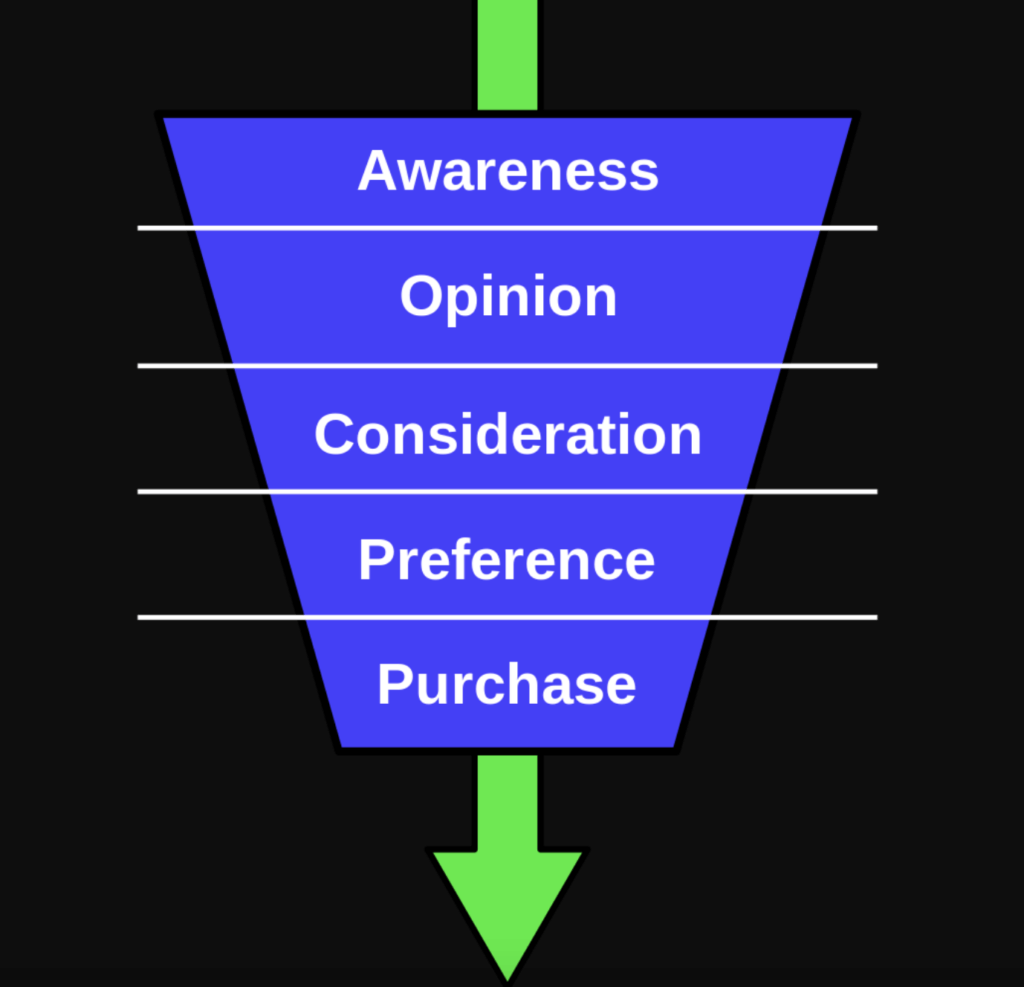
For example, if someone is searching for a specific product or brand on Amazon, they’re likely ready to buy that item right then and there.
Their intent to buy is already so high that it’s much easier to convert their view into a sale.
In contrast, advertising on platforms like Google means your ads are being seen by people in the middle of the purchasing funnel. And the intent to buy isn’t as strong at that point.
And while platforms like Google and Facebook might offer lower cost-per-click advertising (aka pay-per-click) than Amazon, the customer acquisition cost is almost always higher.
That’s because those sites are more established and, therefore, more competitive.
Also, as mentioned above, the majority of traffic a strong DTC brand sees on Amazon should come from organic/unpaid traffic. This is a result of appearing in a lot of search results (shoppers entering in the brand’s name) and being highly ranked in their corresponding categories.
2 Key considerations before deciding to sell on Amazon
Product reviews
Simply stated, reviews on Amazon are product-related.
They address the quality of the item being sold — whether it works properly, is damaged, etc. — and has nothing to do with shipping, packaging, or customer support.
In addition, reviews (and their accompanying star-ratings) are displayed on the product’s listing page. They also influence the item’s ranking in Amazon’s search results.
Therefore, the biggest risk when launching on Amazon are negative reviews, as those comments are often upvoted as helpful, causing potential customers to turn to another listing before they see your positive reviews.
So, make sure you’re selling a high-quality product, and that it’s already received positive customer feedback in-store and/or on your website.
Since bad reviews can break a brand (even if it turns out their product is good), it’s important to know and address any concerns your current buyers have with your offering before you start selling on Amazon.
Seller feedback
On the other hand, seller feedback is all about the seller’s (ie. brand’s) performance. It has absolutely nothing to do with the quality of the product being sold.
Seller feedback deals with the responsiveness of the seller, the packaging of the product, shipping times, and customer support.
In other words, do what you say you’re going to do, and don’t make claims you can’t back up.
if you say your packaging is recyclable, make sure every piece can be reused. If you claim your product is organic, provide the necessary certification as proof. And if you tell shoppers you’ll always respond within 24 hours, send that email before that 24-hour clock runs out.
Making claims on your website that customers don’t agree with or can dispute can result in negative Amazon seller feedback.
However, you can avoid poor Amazon seller feedback ratings the same way you can avoid bad reviews. Know your customers’ complaints before launching and adjusting your Amazon listing content accordingly.
Being familiar with all of your customers’ pain points — including language used to describe your product(s) — is an important step towards ensuring they have the best possible shopping experience when you launch on Amazon.
Seller Central vs Vendor Central
While brands used to be able to choose between selling on Amazon’s Seller Central (SC), Vendor Central (VC), or both, that is no longer an option.
Vendor Central is now invite-only, and invitations are usually reserved for publicly traded companies or businesses making around $5-10 million in sales per year.
*Note: Established brands with lower sales numbers might get invited to Vendor Central if they are successful on Seller Central.But even if you are invited, selling on VC may not be the best move for your DTC brand.
Here are the main differences between these two Amazon selling methods.
Seller Central
Higher profit margins. If the product you’re selling costs $10 or less, Vendor Central is the better choice, as it typically has better margins with lower shipping costs. For food and consumables, it’s almost impossible to make a profit with that price point on SC (Note: this is not true for most categories – e.g. consumer electronics).
Better analytics. When it comes to your brand’s Amazon data, SC offers sellers a number of reports that can help you manage your business. And many of the available reports aren’t offered in Vendor Central, including advertising, performance, inventory , and customizable business reports.
Open to more sellers. Unlike VC, Seller Central is open to almost anyone. As long as you live in an Amazon-approved country, you can register to become a seller on amazon.com.Vendor Central
Distribution model. Being a part of Vendor Central means that Amazon acts like a distributor of your product(s). Instead of selling your products to customers on a one-off basis like you would in Seller Central, Amazon buys large quantities of your product. They then sell them on their site.
Sold by Amazon. Because you’re selling directly to Amazon, your brand is listed as being sold and fulfilled by Amazon. And due to the trust Amazon has built up with shoppers over the years, they’re much more likely to buy from them than a brand they’ve never heard of selling a similar item.
Access to marketing tools. VC sellers have complete access to Amazon’s marketing tools. This includes Sponsored Product Ads, Sponsored Display Ads, and Sponsored Brand Ads. Conversely, SC sellers will only have access to all three types of ads if their product is registered with Amazon’s Brand Registry.
What DTC brands need to know to sell successfully on Amazon
If brands have popular products people want (think Nike) but don’t manage their presence on Amazon (either in-house or with an agency like Cartograph) — or leverage their market’s intel using a tool like Jungle Scout — someone else will sell their products on Amazon and will likely do it badly.
For example, a third-party, non-brand-approved seller may offer products at a higher price, without consumers knowing that the listing does not represent the DTC brand. Or, these alternate vendors could make claims and promises they can’t (or don’t) keep, causing customers with unmet expectations to leave negative seller feedback on their listings.
And though these sellers don’t speak for the brand, since buyers won’t necessarily know that, the higher prices and poor feedback could tank their reputation.
Not to mention, they could also affect a DTC brand’s ability to get distribution in other retail stores.
So, even if they’re not focused on growing their businesses on the platform, DTC brands need — at the very least — a defensive strategy when it comes to Amazon
Be first to market
If businesses don’t embrace the channel and own their brands proactively on Amazon, it will be 10x more difficult for them to clean up the mess other sellers have made of their brands — even for an Apple or a Nike.
But, if you’re the first to market for your own brand, it’s much more difficult for other sellers to toy with you!
Be the first product buyers see
Make sure your listing is the FIRST one shoppers see when they’re searching for a product.
You want your item to appear high in search results, ahead of the other people selling your brand’s product. Then, let those potential buyers know that your product is the real branded item they’re looking for.
When they view your listing, its content should clearly demonstrate your brand’s authenticity.
Also, have a solid keyword strategy. Update your content regularly to keep those keywords relevant and your product at the top of the search results. Plus, test the adjusted listing copy out to make sure it’s helping (and not hurting) your conversions.
Monitor your product’s performance
Keep an eye on the traffic going to your Amazon product listing(s) and storefront, as well as the conversion rate for people who visit those pages.
If you notice a decline in traffic and/or your conversions on Amazon, immediately dig in to find out what’s causing the dip. Ask yourself:
- Is another seller trying to sell the same product?
- Have you been overly elaborate with your content?
- Are you being merchandised in the same places?
- Does your product still appear on the first page of Amazon’s search results?
- Do you still have Amazon’s best-seller badge?
- Is there a better way to target your different customer segments?
Once you determine the cause, fix the problem right away.
Test, retest, and test again
Figure out what does and doesn’t work on your listing.
Split test your product page, and use the resulting scientific data to base your decisions on what content stays and what content goes. And while you can split test anything, these are the areas we recommend you start with:
- Main feature image
- Price (increasing and decreasing)
- Title
- Bullet points
- All other images displayed on your listing
Once you’ve determined the winning variant, set it and move on to your next split test. Or, test the winning variant against a new alternative.
But, to ensure you have the best converting listing possible, definitely keep testing!
Are you a brand that recently started selling on Amazon? Do you have any tips not listed here that have been working for you? Please share them in the comments, as we’d love to hear from you.
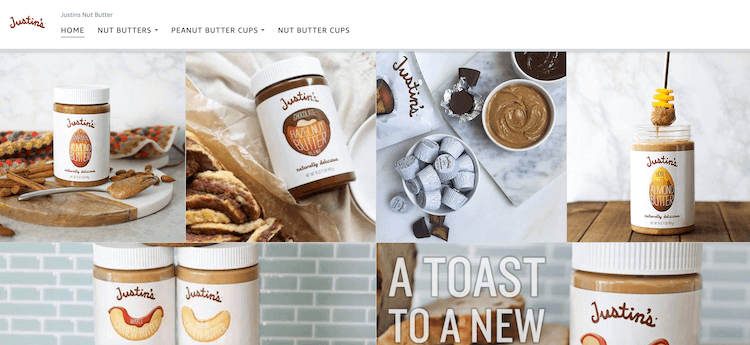
 3 Comments
3 Comments
3 comments on “Direct-to-Consumer Brands on Amazon: Pros, Cons & How to Sell Successfully”